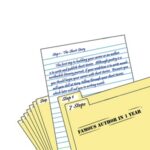Have you ever watched a Hollywood movie and thought you could write better lyrics, better plot, and an all-together better script? Well, it is not as hard as you think! After learning some script formatting basics you could be long ahead on your way of making Hollywood’s next big movie.
Before you begin writing your script, you need a story. Movies are made in all different kind of genres and styles, so the writing possibilities are endless. Once you have an idea in your head, flesh out a basic outline and make sure this story can be turned into a feature-length film. The average page in scripts represent one minute of screen-time, so an average screenplay will be around 90 pages. They do not have to be exactly Ninety pages, more or less depending on the length you plan on. Don’t let the screenplay go on too long though, over 200 hundred pages can be a bit much, and hard to get agents and studios to read.
Now that you have an idea, it is time to start writing the screenplay. You could have the best story, but no one will read your script if the format is not correct so this is one of the most important parts of writing. The start of your script is going to be like the start of every scene you write with a scene heading. If the scene takes place on the inside, the scene heading will begin with INT. for interior. For outside scenes the scene heading will begin with EXT.
Example:
INT. CLASSROOM
EXT. PLAYGROUND
The scene heading is not complete yet. Once the setting is listed, it is followed by a slash and either Day or Night.
Example:
INT. CLASSROOM – DAY
EXT. PLAYGROUND – NIGHT
As seen in the examples, the scene heading is in all caps. You can also get more descriptive with your scene headings. Say you want to focus on the monkey bars of the playground, the scene heading would be written like this:
EXT. PLAYGROUND – MONKEY BARS – NIGHT
There are a few exceptions when using EXT. or INT. Cars driving on the road can be interchanged with EXT. or INT. It all depends on who is reading it, there are different opinions on the subject.
Once your scene heading is in place, skip a line. Now it is time to write what is known as Action. This is where you will describe the setting, actions of characters and introduce characters. It is important to always put in an line of Action, also known as a Slug Line to start and end every scene. When a character is introduced in any scene for the first time, their name is fully capitalized. The caps applies to animals in most cases too.
Example:
INT. CLASSROOM – DAY
MR. TEACHER sits in front of an empty classroom. He’s a white male in his thirties, and wears a blue dress shirt and a red tie.
You can get as descriptive as you want with the character description, either leaving it to the reader, or fully visualizing the character. When writing action it is important to write in present tense and avoid using “-ing”.
NOT CORRECT
MR. TEACHER is sitting in front of an empty classroom. He is not doing much, and begins to walk to the door and starts turning the handle.
CORRECT
MR. TEACHER sits in front of an empty classroom. He sits for a moment then walks to the door and turns the handle.
Writing this way, makes reading the script easier, but sometimes is hard to notice. After a read-through of the script you will begin notice the use of this, but it is an easy correction and a script free of these mistakes will help make it look more professional.
With your action written it is time for the dialog. There are many factors when writing the dialog. The first one to look at is the alignment. Dialog is all centered. The name begins at 3.5 inches across the page and is in all capitals. After the name is typed, the actual dialog written is one line below and is 2.5 inches across the page.
Example:
MR. TEACHER
I thought this day would never end. Time to go home.
There can be more added to the dialog too, in parentheses next to the name.
Example:
MR. TEACHER (WHISPERING)
I thought this day would never end. Time to go home.
When you are having a conversation with two people, a couple of things in the formatting is added.
Example:
MR. TEACHER
I thought this day would never end. Time to go home.
Mr. Teacher turns the doorknob.
MR. TEACHER (CONT’D)
Where are my keys?
Now you have all of the basics of writing a screenplay. Starting with the Scene Heading, adding Action or a Slug Line, and Dialog. Put it all together and eventually you have your first full script. Practice makes it perfect though, and you can be helped out a lot with screen-writing software like Final Draft. Keyboard shortcuts, and automatic recognition of what type of thing you’re writing will greatly speed up the writing process and clean up your script of grammatical errors.
Within a good amount of time, you will be writing screenplays with no problems, and who knows, your idea could become a big-screen hit!








